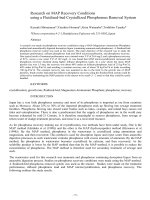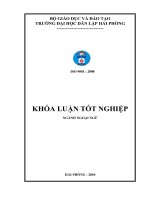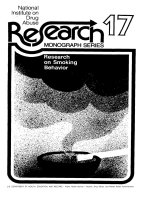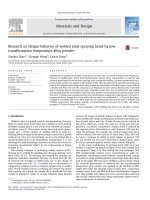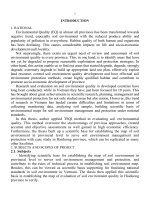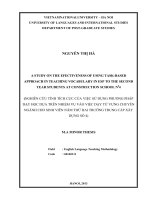A RESEARCH ON CUSTOMER BEHAVIOR WHEN USING PAYMENT BANK CARDS AT TECHCOMBANK NGUYEN HUE, DANANG, VIETNAM
Bạn đang xem bản rút gọn của tài liệu. Xem và tải ngay bản đầy đủ của tài liệu tại đây (1.42 MB, 82 trang )
Bachelor’s Thesis
Degree Programme in Business Administration
International Business
2015
NGUYEN THANH TRUNG
A RESEARCH ON CUSTOMER
BEHAVIOR WHEN USING
PAYMENT BANK CARDS
AT VIETNAM TECHNOLOGICAL
AND COMMERCIAL JOINT STOCK
BANK – TECHCOMBANK NGUYEN
HUE – DANANG, VIETNAM
BACHELOR’S THESIS | ABSTRACT
TURKU UNIVERSITY OF APPLIED SCIENCES
Bachelor of Business Administration | International Business
2015 | 60+22
Instructor: Ajaya Joshi
Author: Nguyen Thanh Trung
A RESEARCH ON CUSTOMER BEHAVIOR WHEN USING
PAYMENT BANK CARDS AT TECHCOMBANK NGUYEN HUE,
DANANG, VIETNAM
The banking services, particularly payment cards, are among the most dynamic and developing
sectors in the expanding economy of Vietnam in recent years. Under the fierce and intense
competition among domestic and international banks, almost every bank has been increasingly
trying to focus on its services in order better to respond efficiently to customers’ ever-changing
behaviors and expectations.
This research seeks to investigate customer behavior when using payment card services at
Techcombank Nguyen Hue, Danang, Vietnam, which includes identifying the underlying factors
and motivations that drive customers’ decision for using payment card services at the Bank, and
more importantly evaluating the customer satisfaction level on the banking services offered. The
research was carried out with the use of quantitative method, collecting primary data from
customers who have been employing the services provided by Techcombank Nguyen Hue, by
using structured questionnaires.
The findings reveal that customers choose Techcombank as a services provider owing to the high
reputation and prestige of the Bank, the large number of ATMs and POS, the safe and convenient
ATM locations, as well as the wide variety of card products’ features. As to customer satisfaction,
the large majority are generally satisfied and appreciate the services provided by Techcombank
Nguyen Hue; however, the price and promotion issues are fairly underestimated, not to mention
some common problems at ATMs. The research also gives some suggestions for Techcombank
Nguyen Hue on how to enhance its services so as to encourage repeat patronage and attract
new customers.
KEYWORDS: consumer/customer behavior, customer satisfaction, payment card, banking
services, service quality, Techcombank, Vietnam
CONTENT
LIST OF ABBREVIATIONS (OR) SYMBOLS................................................................ 7
1
2
INTRODUCTION .................................................................................................... 8
1.1
Research background ....................................................................................... 8
1.2
Rationale for the study .................................................................................... 10
1.3
Research objectives ........................................................................................ 11
1.4
Research questions ........................................................................................ 11
1.5
Thesis structure .............................................................................................. 11
LITERATURE REVIEW ........................................................................................ 13
2.1
Introduction ..................................................................................................... 13
2.2
Consumer behavior ......................................................................................... 13
2.3
The basic factors affecting consumer behavior for using payment bank cards 13
2.3.1
Consumer characteristics ......................................................................... 14
2.3.2
Payment method characteristics ............................................................... 14
2.3.3
Transaction characteristics ....................................................................... 17
2.4
Customer satisfaction ..................................................................................... 19
2.5
Service marketing mix ..................................................................................... 20
2.6
The impacts of service marketing mix on customer satisfaction ...................... 20
2.6.1
Product ..................................................................................................... 21
2.6.2
Price ......................................................................................................... 22
2.6.3
Place ........................................................................................................ 23
2.6.4
Promotion ................................................................................................. 23
2.6.5
Physical evidence ..................................................................................... 24
2.6.6
People ...................................................................................................... 25
2.6.7
Process .................................................................................................... 25
3
VIETNAM TECHNOLOGICAL AND COMMERCIAL JOINT STOCK BANK –
TECHCOMBANK, VIETNAM ...................................................................................... 27
4
5
3.1
About Techcombank Vietnam ......................................................................... 27
3.2
About Techcombank Nguyen Hue Transaction Office, Danang, Vietnam ........ 28
3.3
Techcombank Card Products and Services .................................................... 28
METHODOLOGY ................................................................................................. 32
4.1
Introduction ..................................................................................................... 32
4.2
Choice of research method ............................................................................. 32
4.3
Research strategy ........................................................................................... 33
4.4
Questionnaire design ...................................................................................... 33
4.5
Sampling technique ........................................................................................ 34
4.6
Questionnaire distribution and data collection ................................................. 35
4.7
Data Analysis .................................................................................................. 36
4.8
Limitations of the research .............................................................................. 36
FINDINGS, ANALYSIS AND DISCUSSION ......................................................... 37
5.1
Introduction ..................................................................................................... 37
5.2
Profile of the study sample .............................................................................. 37
5.3
Customer behavior when using Techcombank payment card services ........... 39
5.3.1
Customer motivations and habits for using Techcombank payment card
services ................................................................................................................ 39
5.3.2
Customer satisfaction regarding payment card services provided by
Techcombank Nguyen Hue................................................................................... 48
6
CONCLUSION AND RECOMMENDATION ......................................................... 61
6.1
Introduction ..................................................................................................... 61
6.2
Customer behavior when using payment bank cards at Techcombank Nguyen
Hue, Danang, Vietnam ............................................................................................. 61
7
6.3
Recommendations .......................................................................................... 63
6.4
Implication for further research........................................................................ 67
REFERENCES ..................................................................................................... 68
APPENDICES
APPENDIX 1: TECHCOMBANK ATM LOCATIONS IN DANANG CITY, VIETNAM
APPENDIX 2: SURVEY QUESTIONNAIRE (Translated from Vietnamese)
APPENDIX 3: LETTER OF REFERENCE - PROOF OF CARRYING OUT
AN INTERNSHIP AT TECHCOMBANK NGUYEN HUE, DANANG, VIETNAM
FIRGURES
Figure 1: Rate of cash flow in total payment methods .............................................. 8
Figure 2: Number of issued bank cards over the years ............................................ 9
Figure 3: Customers' Gender .................................................................................... 37
Figure 4: Customers' age .......................................................................................... 38
Figure 5: Customers' education level ....................................................................... 38
Figure 6: Customers' monthly average income ....................................................... 39
Figure 7: Payment cards using situation by categories.......................................... 40
Figure 8: Sources of Techcombank payment card services information .............. 41
Figure 9: Time of using Techcombank payment cards ........................................... 42
Figure 10: Purposes of using payment bank cards ................................................. 43
Figure 11: Customers' use of other bank card services ......................................... 45
Figure 12: Customers' reasons for using Techcombank cards.............................. 45
Figure 13: Frequency of card using by customers .................................................. 46
Figure 14: Customers' methods of using payment bank cards .............................. 47
Figure 15: Number of ATMs of different banks in Danang ...................................... 55
Figure 16: The problems encountered by customers when using cards at ATMs 58
TABLES
Table 1: Customer assessment of the Product ....................................................... 48
Table 2: Customer assessment of the Price ............................................................ 50
Table 3: Customer assessment of the Place ............................................................ 51
Table 4: Customer assessment of the Promotion ................................................... 52
Table 5: Customer assessment of the Physical Evidence ...................................... 54
Table 6: Customer assessment of the People ......................................................... 56
Table 7: Customer assessment of the Process ....................................................... 57
Table 8: Customer intention for long-term use ........................................................ 59
Table 9: Customer word-of-mouth behavior ............................................................ 60
LIST OF ABBREVIATIONS (OR) SYMBOLS
4Ps
Product, Price, Place, Promotion
7Ps
Product, Price, Place, Promotion,
Physical Evidence, People, Process
ACB
Asia Commercial Bank
ASEAN
Association of Southeast Asian Nations
ATM
Automated Teller Machine
DongA Bank
DongA Joint Stock Commercial Bank
Eximbank
Vietnam Export Import Bank
POS
Point of Sale
SeABank
Southeast Asia Commercial Joint Stock
Bank
Techcombank
Vietnam Technological and Commercial
Joint Stock Bank
Vietcombank
Joint Stock Commercial Bank for Foreign
Trade of Vietnam
VietinBank
Vietnam Joint Stock Commercial Bank
for Industry and Trade
8
1 INTRODUCTION
1.1
Research background
A payment card is a means of cashless payment which is very useful in today’s modern
world. This simple and small piece of plastic could be regarded as the greatest source of
personal convenience as individuals no longer have to carry a large amount of cash for
making any purchase. In addition, a payment card is of greater importance when it comes
to making online transactions in the age of digital commerce. These are the essential
advantages that using payment bank cards is a valid option for individuals.
According to the Payments Council, card payments will continually overtake cash in the
years to come, representing a positive shift in the way consumers spend their money.
Whilst the number of cash transactions is forecasted to decrease from 21 billion in 2012
to 14 billion in 2022, the use of payment bank cards is on the rise, from 10 to 17 billion.
(Belfast Telegrapgh, 2013)
In Vietnam, the rate of cash payment has declined over the years, specifically from 31.6%
in 1991 to 11.8% in 2012, based upon the statistics of the State Bank of Vietnam (Vietnam
E-commerce and Information Technology Agency, 2012, 13).
Figure 1: Rate of cash flow in total payment methods
Source: Vietnam E-commerce and Information Technology Agency, 2012, 13
TURKU UNIVERSITY OF APPLIED SCIENCES THESIS | TRUNG NGUYEN
9
Meanwhile, the proportion of non-cash payment has been growing remarkably. In recent
years, the payment bank card market in Vietnam has been developing noticeably,
bringing significant revenue for numerous banks despite of difficult economic condition.
By the end of June 2012, the number of cards issued by banks reached 47.22 million.
(Vietnam E-commerce and Information Technology Agency, 2012, 13-15).
Figure 2: Number of issued bank cards over the years
Source: Vietnam E-commerce and Information Technology Agency, 2012, 15
In addition to payment bank cards significantly contributing to the rising incomes for
banks, they also play a crucial role in fostering the rapid economic growth as well as
improving the legal system in Vietnam, said Nguyen Thu Ha – chairperson of the Vietnam
Card Association under the Vietnam Banking Association from both the macro-economic
and banking perspectives (Vietnam Chamber of Commerce and Industry, 2015). Gordon
Cooper, Visa International’s country manager for Vietnam, Laos and Cambodia also
shared the upbeat outlook on the market potential of Vietnam and said that “Electronic
payments have grown rapidly worldwide and Vietnamese consumers now demand the
convenience of cards” (Vietnam Chamber of Commerce and Industry, 2015).
TURKU UNIVERSITY OF APPLIED SCIENCES THESIS | TRUNG NGUYEN
10
1.2
Rationale for the study
It is clear that the Vietnamese bank card market has been booming lately (Vietnam
Chamber of Commerce and Industry, 2015). Under the fierce competition amongst banks,
each bank has been increasingly trying to focus on its banking services to meet and even
exceed customer expectations. Over the years, Techcombank has proven its position to
be one of the best banks and leading businesses in Vietnam. Additionally, Techcombank
is amongst the top 10 leading banks on number of issued bank cards (Vietnam Ecommerce and Information Technology Agency, 2012, 15).
Furthermore, Techcombank is always the pioneer in improving its service quality over any
other in order to satisfy its customers’ highest demands and expectations. Chakrabarty
(2015) stated that customer satisfaction is the key to the profitability of banks, not to
mention its implication in the retention of customers for the long term, thus lowering the
cost of attracting new customers. I worked for Techcombank Nguyen Hue, Danang,
Vietnam as intern for 5 months period. During my internship, little was revealed about the
customer behavior when using payment bank cards, the evaluation of payment bank card
service quality, as well as the customer satisfaction on its services provided. These are,
of course, crucially significant in improving the Bank’s services in the long run.
In order to further deepen the knowledge on consumer behavior in banking, I would carry
out the research on the behavior of customers when using payment bank cards, including
the satisfaction of individual customers, which might help the Bank to evaluate its
services. Solutions will then be proposed for Techcombank Nguyen Hue on how to
enhance its services in order better to encourage repeat patronage and loyalty, and
attract new customers.
TURKU UNIVERSITY OF APPLIED SCIENCES THESIS | TRUNG NGUYEN
11
1.3
Research objectives
The study is aimed at investigating customer behavior when using payment bank cards
at Techcombank Nguyen Hue, Danang, Vietnam. Accordingly, the research objectives
are:
-
To determine factors and motivations affecting customers for using payment bank
cards at Techcombank
-
To investigate customer satisfaction on payment bank card services provided by
Techcombank Nguyen Hue
-
To propose solutions to maintain and improve the service quality of payment bank
cards in order to encourage repeat patronage and loyalty, and attract new
customers.
1.4
Research questions
In order to achieve those proposed objectives, the study is aimed at answering the
following research questions:
1. Which factors and motivations affect customers’ decision for using payment bank
cards at Techcombank Nguyen Hue?
2. To what extent the customers are satisfied with the quality of each service
component in payment bank card system at Techcombank Nguyen Hue?
1.5
Thesis structure
The study will be divided into six main chapters.
Chapter 1: Introduction
In this chapter, the research background which is the payment bank card and card market
situation in Vietnam is provided, followed by the rationale why the research is worth
conducting. The highlights of research objectives as well as research questions are also
clearly presented.
TURKU UNIVERSITY OF APPLIED SCIENCES THESIS | TRUNG NGUYEN
12
Chapter 2: Literature Review
This chapter provides the theoretical background for the research by reviewing of
previous studies in the similar fields. Specifically, the concept of consumer behavior, the
underlying factors affecting customer behavior for using payment bank cards, and the
service marketing mix and its impacts on customer satisfaction are discussed.
Chapter 3: Company profile
An
overview
of
Vietnam
Technological
and
Commercial
Joint
Stock
Bank
(Techcombank), Techcombank Nguyen Hue – a transaction office directly under
Techcombank Vietnam, and its main business related to payment card products and
services is introduced.
Chapter 4: Methodology
The research methodology applied for this study, including the choice of method, the
construction of method, the sampling technique, the data collection process, and data
analysis, is explained. This is followed by the identification of limitations of the research.
Chapter 5: Findings, Analysis, and Discussion
Chapter 5 covers the data collected from primary source which is survey questionnaire.
The interpretation, analysis and discussion about the results are described in detail.
Chapter 6: Conclusion and Recommendation
This chapter summarizes the key findings and provides conclusion in terms of customer
behavior when using payment cards at Techcombank Nguyen Hue, including the
motivations for using and customer satisfaction on services provided. The suggestions
are then given for Techcombank Nguyen Hue on how to improve its service to retain
repeat customers and attract new ones. Implication for further research is also proposed
at the end.
TURKU UNIVERSITY OF APPLIED SCIENCES THESIS | TRUNG NGUYEN
13
2 LITERATURE REVIEW
2.1
Introduction
Chapter one introduced the research objectives with the main aim to examine customer
behavior when using payment bank cards. The specifics are to identify the factors and
underlying motives that drive customers’ choice of payment methods; and to evaluate
customer satisfaction on the bank card services. These require the review of previous
studies in the similar field to develop a theoretical background for the research.
Accordingly, the concept of consumer behavior, plus the basic factors which might have
an influence on customers’ decision will be discussed. It is then followed by the concept
of customer satisfaction, and the service marketing mix (7Ps) which is identified to be
significant in delivering customer satisfaction on service product.
2.2
Consumer behavior
Consumer behavior is referred to all the activities of individuals, groups or organizations
in searching for, purchasing, using and assessing of products or services, including the
consumers’ emotional, mental, as well as behavior responses that precede, determine,
or follow these activities (Kardes, et al., 2008, 8-9). According to Solomon, et al. (2013,
6), consumer behavior is as the actions and decision processes of individuals and
households in discovering, evaluating, acquiring, consuming and then disposing of
products by utilizing their existing and available assets, such as money, time or effort. In
other words, it entails all the activities of the consumers as well as the underlying
motivations associated with those actions. The field of consumer behavior is therefore the
study of the process of how individual consumers or groups select, purchase, use and
dispose ideas, products, services or experiences that fulfill customers’ needs and desires
(Solomon, et al., 2013, 6).
2.3
The basic factors affecting consumer behavior for using payment bank cards
Over the decades, there have been dozens of studies that investigate consumer behavior
towards the use of payment bank cards, together with the fundamental motives
TURKU UNIVERSITY OF APPLIED SCIENCES THESIS | TRUNG NGUYEN
14
influencing card payment choice amongst consumers. The results have revealed that
individual consumers are mostly effected by three main groups of factors worth
considering, which are consumer characteristics, payment method characteristics and
transaction characteristics (Ching and Hayashi, 2006, 9).
2.3.1 Consumer characteristics
Consumer characteristics, which are demographic and financial attributes, were found to
be fundamental determinants that potentially have a great influence on payment behavior
of consumers (Hayashi and Klee, 2003, 176; Klee, 2006, 7; Zinman, 2008, 19). Another
research by Schuh and Stavins (2011, 3) also asserted that the effect of those
components is consistent with preceding studies. Demographic variables include age,
gender, education, income, race, marital status, etc. Arango and Taylor (2009, 12); Schuh
and Stavins (2011, 20), for example, both pointed out that while younger customers were
associated with the use of more debit cards, the older used more checks; and the bettereducated people tended to use credit cards. In regards to income, people with low income
spent more cash; in contrast, those with higher salary used debit and credit cards
intensively. The findings also revealed that the matter of having financial responsibility for
paying bills did not considerably influence the choice of payment methods, such as cash,
checks or payment bank cards.
2.3.2 Payment method characteristics
Although the aforementioned demographic and financial variables have been found to be
correlated to consumer payment behavior, some authors, notably Schuh and Stavins
(2011, 3) identified that the perceived characteristics of payment are of crucial importance
for both the adoption and the use of payment method. Each payment instrument carries
with it some exclusive attributes, such as transaction speed, cost, convenience, security,
restraint, records keeping and acceptance (Borzekowski et al., 2006, 10; Ching and
Hayashi, 2006, 10; Schuh and Stavins, 2011, 17). Accordingly, each attribute of payment
instrument will be discussed in terms of payment card as follows.
TURKU UNIVERSITY OF APPLIED SCIENCES THESIS | TRUNG NGUYEN
15
2.3.2.1.
Transaction speed
Transaction speed is referred to the time a certain payment method takes for customers
to perform a payment transaction. Borzekowski et al. (2006, 10) provided evidence that
a preference for speed is amongst the most desired features that drive the payment
choice of users. For instance, the time that card payment takes at the check-out counters/
POS, or the time the system consumes when customers withdraw the money from ATMs
is typically taken into consideration to customers’ choice of using bank cards.
2.3.2.2.
Cost
Cost includes service fees, interest paid or lost, penalties, subscriptions or materials. It is
obvious that customers who are using payment bank card services have to pay for some
certain fees such as per-transaction cost and monthly, term or annual fees depending on
regulations of each bank. Furthermore, for the users of credit cards, they must pay their
credit balance in full by the due day; otherwise, the interest on the charge starts
immediately. Previous research has established that cost substantially contributes to the
choice of payment methods (Borzekowski et al., 2006, 10; Schuh and Stavins, 2011, 1).
Cost is therefore significant both in adoption as well as in use of bank cards.
2.3.2.3.
Convenience
According to Schuh and Stavins (2011, 31), convenience is regarded to the degree to
which people can save time, effort to carry, or ability to keep or store, or do some physical
requirements at the time of payment. In their study, convenience driver was statistically
demonstrated to be associated to the consumer choice of card usage. This view is also
reinforced by Borzekowski et al. (2006, 19), in their empirical paper, convenience is
overwhelmingly cited as a main reason for using debit cards. Additionally, the
convenience in consumers’ use of bank cards was specifically investigated in the study
by Arango and Taylor (2009). These authors found that consumers perceiving bank cards
to be more convenient and less risky than cash use them more frequently and consumers
substantially shift away from cash and towards alternative payment methods (Arango and
Taylor, 2009, 12).
TURKU UNIVERSITY OF APPLIED SCIENCES THESIS | TRUNG NGUYEN
16
2.3.2.4.
Security
Security is defined as “Security against permanent financial loss or wanted disclosure of
personal information when a payment method has been stolen, misused or accessed
without the owner’s permission.” (Schuh and Stavins, 2011, 31). Based upon the research
by Zinman (2008, 3), the improved security was a significant proximate of recent growth
of debit card users. Security is, in fact, of crucial importance in explaining the payment
methods that customers choose to do transactions. For many, in this age of advanced
technology, they would prefer holding bank cards due to the prevention of theft, robbery,
loss, or counterfeit money. On the other hand, others are still fond of spending by cash
instead of cards as they are afraid of disclosing personal information, and exposing risks
of fraud activities when the cards are lost or stolen. Customers, however, would mostly
feel secure and put their mind at ease because they are always protected by liability
agreements with card issuers and merchants when these problems happen. Furthermore,
the concern of security was emphasized in the research by Schuh and Stavins (2011, 17)
who concluded that people seeing the payment method as relatively more secure are
more likely to adopt it and vice versa. Security is, therefore, vital when it comes to
understanding the consumer behavior for using payment bank cards.
2.3.2.5.
Restraint and Records Keeping
Payment card adoption was also affected by the characteristics of restraint which is a
desire to limit and control overspending, and record keeping that is an ability to track and
record purchases (Borzekowski et al., 2006, 10; Schuh and Stavins, 2011, 17). As a
matter of fact, by using payment bank card services, cardholders can easily keep track of
their expenses, the actual payment as well as deduction of funds from their bank accounts
over the time in order better to avoid overspending. Moreover, additional information such
as time and date of payment or where the payments made is also shown in transactions
record which might help the users to control and manage their account. Particularly, in
case of credit card users, the feature of record keeping can potentially help in building
credit history that would bring benefits for customers. Results of the 2006 survey
regressions revealed that the effect of record keeping was strong for credit and debit
cards although the coefficient is quite negative for debit (Schuh and Stavins, 2011, 19).
TURKU UNIVERSITY OF APPLIED SCIENCES THESIS | TRUNG NGUYEN
17
Hence, these characteristics of restraint and record keeping would be potentially favored
by card users, and definitely significantly affect the choice of payment instruments.
2.3.2.6.
Acceptance
Schuh and Stavins (2011, 31) defined acceptance as “how likely each payment method
is to be accepted for payment by stores, companies, online merchants, and other people
or organizations.” In fact, the effect of acceptance has a strong influence on the card
usage. To be more specific, it is usually seen that for some retail stores or departments,
only cash is accepted. This could be seen more clearly in some Asian countries, such as
Vietnam, where the payment bank cards have not been used extensively and widely as
expected; and there has been a limited number of ATMs and POS units. These
disadvantages are therefore barriers that partially prevent customers’ choice of card
payments. Several previous empirical papers have proved the influence of physical
environment, namely the availability of card payment acceptance at POS, on payment
method choices of whether or not using bank cards. Specifically, Bolt et al. (2008, 94)
investigated the difference in payment instrument use between Norway and The
Netherlands and eventually concluded that due to the fact that Norway started with more
payment terminals than the Netherlands, thus leading to the higher point of card usage
on the growth curve.
2.3.3 Transaction characteristics
Aside from the main contributors above, several authors concluded that customer’s
choice of payment methods is also derived from their use in transactions; therefore the
transaction characteristics are of high importance. The transaction characteristics include
reward incentives and payment size. (Bounie and François, 2006, 4; Ching and Hayashi,
2006, 9).
2.3.3.1.
Reward incentives
As a leading strategic way, in order to propel the growth of payment card usage, banks
usually offer reward programs to their customers, such as gifts, discounts, coupons or
accumulated points for special offers. Specifically, for instance, by doing card payments
TURKU UNIVERSITY OF APPLIED SCIENCES THESIS | TRUNG NGUYEN
18
at POS or ATMs, customers are capable of saving certain points to their credit history;
and in the end, when the total value of transactions reaches a certain level set by bank,
they will receive some special offers. In the empirical research on the effects of payment
card reward program on consumer payment choice, Ching and Hayashi (2006, 18-19)
suggested that consumers who are granted credit card rewards use credit cards much
more extensively than those who are not, and reward card transactions are inclined to
replace both paper-based and non-reward card transactions. Furthermore, CarbóValverde and Liñares-Zegarra (2011, 21) also emphasized the importance of rewards by
saying that reward programs significantly affect the preferences for cards relative to cash
payment and that the marginal effect of these programs is the highest among the posited
set of explanatory factors. Due to this feature, it can be said that reward could be a good
predictor for the preferences of different payment methods.
2.3.3.2.
Payment size
Payment size which is explained as a value of each transaction is shown to be a
concerned determinant to the payment choice of consumers (Ching and Hayashi, 2006,
9). It is likely that consumers have a tendency of spending cash for small value payments;
whereas larger value transactions are conducted by payment bank cards. Bounie and
François (2006, 14) also affirmed on this point of view that the transaction size influences
the probability of a transaction being paid by one of three payment instruments, namely
cash, check and bank cards, and that the larger a transaction, the higher the probability
of it being paid by check or bank cards.
Besides all the three sets of above-mentioned factors, in the context of Vietnam, another
point worth considering is that, in 2007, the Prime Minister issued the Instruction No.
20/2007/CT-TTg on paying salaries via bank cards for workers, officials and others who
are receiving salaries from the government budget (VnBusinessReg, 2014). Due to this,
Vietnamese people who work for many and various different state sectors have to use
payment bank cards to get paid, thus bringing an ever increasing number of card users
in recent years. As a result, it helps foster the fast growing bank card market of Vietnam.
This factor therefore plays an important role in influencing customer behavior for using
bank cards in Vietnam.
TURKU UNIVERSITY OF APPLIED SCIENCES THESIS | TRUNG NGUYEN
19
2.4
Customer satisfaction
Customer satisfaction is a frequent term and most studied areas in marketing, and the
importance of it has been proven by many researchers over the years. Customer
satisfaction has been bringing many undeniable benefits for firms and organizations, such
as positive worth-of-mouth advertising or referrals, increased sales volume from repeated
purchases, failure cost reduction, sustainable advantages from customer loyalty and
repeat patronage, competitor isolation and many more (Baron and Harris, 2003, 150;
Hoffman and Bateson, 2010, 290-291). An exhaustive review of Yi (1991- see Grigoroudis
and Siskos, 2010, 4) revealed that customer satisfaction is basically referred to two ways,
either as an outcome or as a process. To be more precise, as an outcome, satisfaction is
viewed as a post-purchase evaluation resulting from the consumption experience
(Grigoroudis and Siskos, 2010, 4; Lovelock and Wirtz, 2011, 323). As a process, it
emphasizes the perceptual, evaluative, and psychological process that eventually leads
to satisfaction of customers (Grigoroudis and Siskos, 2010, 4).
There are different approaches to define customer satisfaction based on different
perceptions. The most popular definitions, however, are based upon the fulfillment of
customer expectations (Grigoroudis and Siskos, 2010, 4). Barron and Harris (2003, 136),
for instance, viewed customer satisfaction as a function of similarities between the
previous expectations with the actual performance of a product or service after its use.
Kotler and Keller (2012, 129) agreed with this assertion, adding that satisfaction is the
customers’ feelings of pleasure or disappointment after comparing their expectations and
real perceived experience. Likewise, customer satisfaction was defined by Solomon, et
al. (2013, 328) as the overall attitude or feelings of customers about a product or service
after purchasing and using it. Customers therefore take part in the process of evaluating
products or services as they are the ones who integrate those products/services into their
life. The comprehensive definition is that “satisfaction is the consumer’s fulfillment
response. It is a judgment that a product/service feature, or the product or service itself,
provided (or is providing) a pleasurable level of consumption-related fulfillment, including
levels of under- or over fulfillment.” (Oliver, 2010, 8).
TURKU UNIVERSITY OF APPLIED SCIENCES THESIS | TRUNG NGUYEN
20
2.5
Service marketing mix
In 1960, McCarthy initially suggested the concept of the marketing mix – the 4Ps, namely
product, price, place and promotion with the ultimate aim to generate, fulfill and sustain
the satisfaction of customers (Drummond and Ensor, 2005, 8). According to him, the 4Ps
are the vital decision areas, in which each variable P includes different factors that
marketers need to emphasize to create perceived value, meeting the needs of each target
customer group in a certain specific marketplace. Solomon et al. (2013, 9) supported this
assertion by saying that each customer segment can be reached by an appropriate
specific marketing mix and they will respond in a desired way to the marketing mix
designed for them. In other words, the target specific group is a specific marketing mix
(Drummond and Ensor, 2005, 9). This traditional marketing mix has been proved to be
essential to manufacturing-based or tangible products. In terms of service-based
products, however, due to the four distinct characteristics of services, which are
intangibility, perishability, variability/heterogeneity, and inseparability, the mix should be
expanded to the 7Ps by adding physical evidence, process and people in order to
consider other elements particularly relevant to services (Zeithaml and Bitner, 2000, 18;
Moorthi, 2002, 259; Baron and Harris, 2003, 25-26; Drummond and Ensor, 2005, 10).
2.6
The impacts of service marketing mix on customer satisfaction
It is said that recognizing the importance of customer satisfaction in the success of
business, the concept of original marketing mix (4Ps) by McCarthy (1960) and then the
service marketing mix by Booms and Bitner (7Ps) were come out with the underlying goal
to generate and sustain customer satisfaction (Baron and Harris, 2003, 25-26; Drummond
and Ensor, 2005, 8). Since then, the relationship between marketing mix and customer
satisfaction has been highly examined and explored throughout many different business
sectors; as a result, most of the research studies have indicated the positive effects of the
marketing mix towards customer satisfaction. As an example, Madmud (2006), in his
study about customer satisfaction related to marketing mix of Jamuna Bank Limited in
Bangladesh, concluded that overall customer satisfaction derived from different elements
of the service marketing mix (7Ps) of their bank. Similarly, Jaarsveld and Heerden (2007)
TURKU UNIVERSITY OF APPLIED SCIENCES THESIS | TRUNG NGUYEN
21
conducted a study in the relationship between selected marketing mix elements and
overall customer satisfaction in South African banks, empirically finding that respondents
viewed all the factors, namely physical evidence, people, process and price, as equally
important to their perception. Another research by Ling (2007) also supported the positive
effects of marketing mix in building a model in deriving consensus rankings from
benchmarking, from which evaluate customer satisfaction at different retail stores, as a
result setting a benchmark about product, price, promotion or place strategies to compete
in the market. Mattsson (2009) also adapted a model of service marketing mix to measure
customer satisfaction in the retail market in Finland, specifically at Gant store, and
revealed that aside from basic elements such as product, place or price, other substantial
factors namely physical evidence (the style or image of the store), people (kindness of
sales people) and business process play crucial role in delivering customer satisfaction.
After a review of previous studies, most of them strongly support the positive impacts of
service marketing mix on customer satisfaction. This study therefore adopts the marketing
model (7Ps) in order to investigate and measure the satisfaction of customers who are
using payment bank cards at Techcombank Nguyen Hue. Accordingly, each element of
the service marketing mix will be described in more detail as follows.
2.6.1 Product
According to Drummond and Ensor (2005, 9), in general, products are solutions to
customers’ needs. Lovelock and Wirtz (2011, 106) supported this assertion, then
specifically defining this term in regards to services: “a service product comprises all of
the elements of the service performance, both physical and tangible, that create value for
customers.” Specifically, the service product is made up of core, augmented and
supplementary products.
Firstly, the core product is the central component that provides the benefits or solutions
that the customers actually seek for (Lovelock and Wirtz, 2011, 106). In this study, the
core product is to provide payment card product, coupled with associated services that
help customers to handle finance-related issues. Secondly, the actual product comprises
some tangible aspects of product, such as brand name, range offered, features, quality,
TURKU UNIVERSITY OF APPLIED SCIENCES THESIS | TRUNG NGUYEN
22
or design (Lovelock and Wirtz, 2011, 106). Research has shown, for example, that service
quality is among the factors that have an influence on customer satisfaction
(Parasuraman et al., 1994-see Chakrabarty, 2014). This view is also reinforced by
Anderson and Sullivan (1993-see Charabarty, 2014) who state that strong linkages are
apparent between service quality and overall customer satisfaction. Finally, the
augmented product supplies the additional services for its core element; for example,
customer service support (Lovelock and Wirtz, 2011, 107). The product dimension also
involves the influence of human factor, both providers and customers in terms of how it
is delivered and perceived (Gilmore, 2003, 12). All things considered, these
characteristics help facilitate the product’s use as well as improving its value for the
customer’s experience. It is product which is basically considered as the crucial element,
from which other remaining elements develop and decisions to be made (Drummond and
Ensor, 2005, 9).
In this study, the product element of the mix will be considered through the attributes: the
range offered, the features and especially the quality of card payment products and
services.
2.6.2 Price
Price is defined as the amount of money that customers pay for a product or service that
they acquire. In other words, price determines what a provider is paid. (Drummond and
Ensor, 2005, 9). Furthermore, price is the only element of the marketing mix that creates
revenue; whereas the others create costs (Drummond and Ensor, 2005, 134). Lovelock
and Wirtz (2011, 158-159) later confirmed and reinforced the notion that price helps
generate profits, cover costs and build demand as well as developing a user base. For
services, price becomes more complex due to the characteristic of intangibility; therefore,
it is more difficult for customers to evaluate (Lovelock and Wirtz, 2011, 159). More
importantly, the perception of value, which is highly related to the pricing element, varies
according to individual customers, thus making the pricing decisions become more
difficult and imprecise for managers (Gilmore, 2003, 12).
TURKU UNIVERSITY OF APPLIED SCIENCES THESIS | TRUNG NGUYEN
23
In this research, price will be reflected from present customers’ perceptions in order to
see to what extent that customers are satisfied with the payment bank card services in
exchange for their money.
2.6.3 Place
Place represents the distribution and location of the service offering to the market. Any
service distribution strategy would response to four basic questions of what, how, where
and when. In addition, some core services require a physical location, yet supplementary
services can be delivered remotely. (Lovelock and Wirtz, 2011, 132). Importantly, place
is referred as an easy access so that both customers and service providers can benefit
from (Drummond and Ensor, 2005, 163). For instance, convenient places and a wide
range of location availability will substantially lead to an increase in the levels of
customers’ accessibility as well as buying decisions. Therefore, the location of premises
is vital.
Within the scope of this study, the location of bank office, ATM machines, and the
distribution of POS units, which are considered as crucially important dimensions of place
that significantly contribute to customer satisfaction, will be taken into consideration.
2.6.4 Promotion
The promotional element of the marketing mix is in charge of providing communication
with the desired customers. To be more specific, promotion helps companies to spread
out the information about product or service offerings to a target market (Drummond and
Ensor, 2005, 9). In other words, “Through communication, marketers explain and promote
the value proposition their firm is offering.” (Lovelock and Wirtz, 2011, 186). There have
been a number of ways that businesses can employ to communicate with their customers;
for example, advertising, internet marketing, public relations, salespeople, sales
promotion, social media, and sponsorship, or the blend of these methods that is called
the communication mix (Drummond and Ensor, 2005, 9). Moreover, the use of deployed
promotion mechanism could vary depending on types of products and service sectors,
not to mention the company’s existing and available budgets. It is conceded that the role
TURKU UNIVERSITY OF APPLIED SCIENCES THESIS | TRUNG NGUYEN
24
of marketing communication is of high importance to a company’s success (Lovelock and
Wirtz, 2011, 186). This is because it not only makes customers aware of a product/service
offering, but also develops a long-term relationship with customers as well as generating
and stimulating demand (Drummond and Ensor, 2005, 9).
In this study, the promotional element will be discussed from customers’ perspectives in
terms of the product and service information they are informed, and the sales promotion
in forms of special sales package, voucher, or coupon they acquire when using payment
card services.
2.6.5 Physical evidence
Due to the characteristic of intangibility of service products, customers cannot have
physical evaluation of a service product itself as they cannot touch, smell, or feel. As a
result, it is quite difficult for customers to evaluate whether or not a service product meets
their expectations, especially quality and value for money before purchasing. (Lancaster
and Massingham, 2011, 511). Nevertheless, customers might look for physical evidence
as an indicator of satisfaction (Drummond and Ensor, 2005, 10). Zeithaml and Bitner
(2000, 20) considered physical evidence as the environment where the interaction
between service providers and customers take place, thus a service is delivered.
According to Baron and Harris (2003, 8), the physical evidence consists of both the
internal and external environment to the service setting, the equipment and technology
that customers may encounter in dealing with the service. More specifically, Gilmore
(2003, 12) and Lancaster and Massingham (2011, 511-512) referred these elements as
building facilities, including facility exterior (design, signage, surrounding environment)
and facility interior (equipment, layout) and ambience (temperature, lighting, sound).
Finally, he concluded that physical evidence is everything that provides tangible clues for
customers to evaluate services (Gilmore, 2003, 12).
This study will focus mainly on the building facilities and ambience of transaction office
and ATMs, as well as the availability of POS units as main indicators of physical evidence.
TURKU UNIVERSITY OF APPLIED SCIENCES THESIS | TRUNG NGUYEN
25
2.6.6 People
Many and various services are people-based and hence the quality of service provision
mainly depends on the element of people who are in charge of delivering the service
(Drummond and Ensor, 2005, 10). Lovelock and Wirtz (2011, 302) maintained that people
are crucially important to the success of the service firm, especially in a service delivery
process because any service is inseparable from the people who provide it. These
authors strongly emphasized the importance of service personnel who play an essential
role as: a source of competitive positioning, generating sales, a key driver of productivity
of the frontline operations, a source of customer loyalty, and ‘moments of truth’
encounters (Lovelock and Wirtz, 2011, 302-303). In addition, Hoffman and Bateson
(2010, 232) asserted another role of human resource that when different organizations
have the same business activities concept, it is people who make a distinctive difference
through customer-employee interaction and relationship. Therefore, personnel’s service
skills, appearance, attitude as well as motivation will determine customer satisfaction
(Gilmore, 2003, 13), (Hoffman and Bateson, 2010, 232).
In this research, the element of people will be examined with regard to the appearance,
attitude as well as service skills of the Bank’s employees.
2.6.7 Process
According to Baron and Harris (2003, 95), “service is a process not a tangible product”.
And process is the method by which a service is delivered to its customers; for example,
the procedures that ensure an effective and efficient service (Gilmore, 2003, 12;
Drummond and Ensor, 2005, 10). By the same token, Lovelock and Wirtz (2011, 337)
defined process as the way in which the service is designed and managed to deliver value
of service offerings to customers. To be more specific, process involves procedures,
tasks, schedules, activities and routines that help form facilitation element of the service
offering to deal with customers at the contact point (Drummond and Ensor, 2005, 10). So,
it is clear that the process function plays an essential role in the marketing mix. Poor
process is likely to make customers annoyed as it results in low and poor quality service
delivery, then leading to poor productivity, and the risks of failures (Lovelock and Wirtz,
TURKU UNIVERSITY OF APPLIED SCIENCES THESIS | TRUNG NGUYEN
